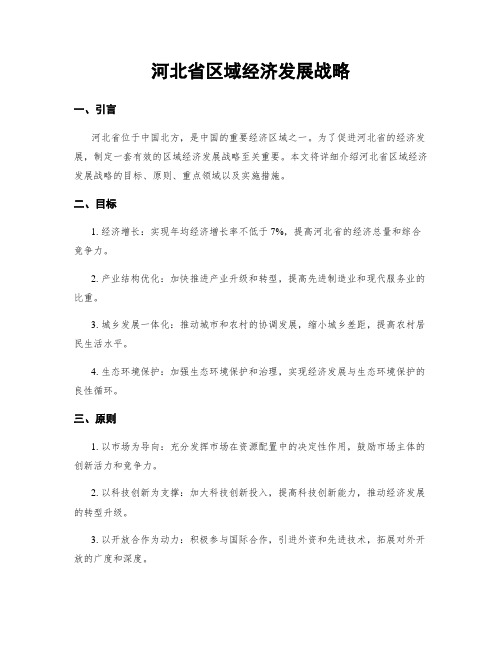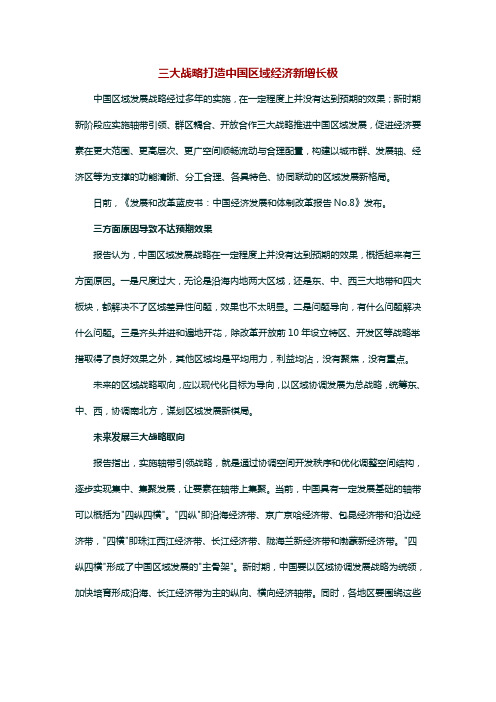最新区域经济发展战略
区域经济发展战略

建国后,为了冷战时期备战的需要,国家曾以优惠的财政政策和大量的投资加快内地的工业发展。这一政策 限制了沿海地区的经济发展,从而使东西部地区的经济发展差距逐渐缩小。然而,由于中西部地区自然环境和经 济环境基础较差,投资回报率明显低于沿海地区,多项数据都表明了这种强调内地发展的政策在很大程度上牺牲 了整体经济发展的效率,表面上缩小了内部差异,实际上导致了中外差异的扩大。
区域经济发展战略
经济学术语
01 特点介绍
03 形成 05 国内演变
目录
02 现实意义 04 走势趋向
基本信息
区域经济发展战略是指对一定区域内经济、社会发展有关全局性、长远性、关键性的问题所作的筹划和决策。 说得更具体些,是指在较长时期内,根据对区域经济、社会发展状况的估量,考虑到区域经济、社会发展中的各 方面关系,对区域经济发展的指导思想、所要达到的目标、所应解决的重点和所需经历的阶段以及必须采取的对 策的总筹划和总决策。
总结建国以来区域经济布局的经验教训,人们理性地认识到,东部沿海与中西部地区经济发展是矛盾统一的。 不顾东西部地区的客观差异,人为地推行均衡发展政策,实践证明是行不通的。指出:“我们讲共同富裕,但也 允许有差别。”他认为搞平均主义的同步富裕、同时富裕,不符合社会主义按劳分配的原则,只是一种空想,其 结果只能造成共同贫穷。因此他再三强调:“过去搞平均主义,吃‘大锅饭’,实际上是共同落后、共同贫穷, 我们就是吃了 战略性 长期性 稳定性 政策性
区域经济发展政策和策略

区域经济发展政策和策略随着全球化和城市化的不断加速,区域经济发展已成为当今世界各国政府普遍关注和重视的问题之一。
然而,不同国家、不同地区的经济发展状况和经济结构大不相同,因此,制定适合本地区的经济发展政策和策略显得尤为重要。
一、政府支持和奖励企业发展政府的支持和奖励政策是促进区域经济发展的重要手段之一。
政府可以通过税收、贷款和资金补贴等方式来支持和鼓励企业发展,帮助企业减轻负担和风险。
政府还可以通过出台奖励政策来支持企业创新和高新技术的发展。
二、招商引资和经济特区建设招商引资是提高地方经济发展水平的重要途径之一。
政府可以通过物流、人力资源、政策优惠等方面为企业提供优越的发展环境,吸引更多的投资者和企业到本地区投资和创业。
另外,经济特区的建设可以为当地的经济发展提供更大的空间和机遇,使得当地的经济更加繁荣。
三、加强人才培养和科技创新人才和科技是区域经济发展的两个重要驱动因素。
政府可以通过资助高职院校和科研机构,提高人才培养的质量和数量,为经济发展提供强有力的人才支持。
同时,政府还可以加大对科技创新的投入和支持力度,促进高新技术的发展和应用,助力区域经济发展。
四、推进产业结构调整和升级产业结构调整和升级是区域经济可持续发展的关键环节。
政府可以通过制定相关政策,引导企业加强科技创新和转型升级,提高产品附加值,推动产业结构调整和升级。
此外,政府还可以通过推进农业现代化、发展战略性新兴产业等途径,拓展经济发展新的增长点和潜力。
总之,区域经济发展政策和策略的制定和实施需要综合考虑地区经济基础、产业结构、人才资源、政策环境等多个因素,以实现区域经济稳步增长和可持续发展。
“十四五”区域发展四大战略方向

“十四五”区域发展四大战略方向“十四五”是指中国国家发展规划第十四个五年计划,即2024年至2025年。
在这个时期,中国政府将继续推动区域发展,以实现经济社会的全面进步和可持续发展。
在“十四五”规划中,有四个战略方向将成为实施区域发展的核心。
本文将详细介绍这四个方向。
首先,要加强区域协调发展。
中国是一个拥有广泛区域差异的国家,各地区的发展水平和条件存在较大差异。
加强区域协调发展是解决这些差异问题的关键。
这一战略方向包括以下几个方面的内容。
第一,要构建区域协调发展的政策体系和机制。
政府应制定相关政策和措施,加强各地区间的合作和交流,促进资源要素的流动和分配的合理性。
第二,要推进区域间基础设施建设的协同发展。
通过加快交通、通信、能源等基础设施建设,无障碍交通条件的改善,能源的高效利用等,促进各地区之间的互联互通。
第三,要增强区域合作发展的动力。
政府应加强对各地区在发展中遇到的问题的指导和支持,推动资源要素的跨区域流动,促进各地区的经济互补和协同创新。
第四,要加大对欠发达地区的支持力度。
政府要进一步加大对欠发达地区的资金投入,加强对欠发达地区的帮扶力度,提高其发展能力和发展水平。
第二,要推动创新驱动发展。
创新是推动经济社会发展的重要动力,也是实现高质量发展的重要保障。
在“十四五”期间,要推动创新驱动发展的战略方向,包括以下几个方面的内容。
第一,要大力推进科技创新。
政府应加大对科技研发的支持力度,加强科技创新平台的建设,提高科技成果转化的效率和速度,为创新创业提供更好的环境。
第二,要加强人才培养和引进。
政府应制定相关政策和措施,吸引优秀人才的流动,提供更好的培养和发展机会,培养更多的科技创新人才。
第三,要推动产学研用结合。
政府应加强产学研用结合的机制建设,构建创新生态圈,促进产业创新和科技创新的深度融合。
第三,要推动绿色发展。
绿色发展是实现可持续发展的必然选择,在“十四五”期间,推动绿色发展的战略方向包括以下几个方面的内容。
河北省区域经济发展战略

河北省区域经济发展战略一、引言河北省位于中国北方,是中国的重要经济区域之一。
为了促进河北省的经济发展,制定一套有效的区域经济发展战略至关重要。
本文将详细介绍河北省区域经济发展战略的目标、原则、重点领域以及实施措施。
二、目标1. 经济增长:实现年均经济增长率不低于7%,提高河北省的经济总量和综合竞争力。
2. 产业结构优化:加快推进产业升级和转型,提高先进制造业和现代服务业的比重。
3. 城乡发展一体化:推动城市和农村的协调发展,缩小城乡差距,提高农村居民生活水平。
4. 生态环境保护:加强生态环境保护和治理,实现经济发展与生态环境保护的良性循环。
三、原则1. 以市场为导向:充分发挥市场在资源配置中的决定性作用,鼓励市场主体的创新活力和竞争力。
2. 以科技创新为支撑:加大科技创新投入,提高科技创新能力,推动经济发展的转型升级。
3. 以开放合作为动力:积极参与国际合作,引进外资和先进技术,拓展对外开放的广度和深度。
4. 以人才为核心:加强人才培养和引进,提高人才的创新能力和竞争力。
四、重点领域1. 先进制造业:加强装备制造、新材料、新能源等领域的创新和发展,提高制造业的技术水平和附加值。
2. 现代服务业:发展金融、信息技术、文化创意等高附加值的现代服务业,提升服务业的质量和效益。
3. 农业现代化:推进农业供给侧结构性改革,培育农业新业态,提高农业的竞争力和可持续发展能力。
4. 城市建设:加强城市基础设施建设,提高城市的宜居性和吸引力,促进城市经济的繁荣发展。
五、实施措施1. 完善政策支持:制定相关政策,鼓励企业投资和创新,提供财税、金融、土地等方面的支持。
2. 加强基础设施建设:加大投资力度,提升交通、能源、通信等基础设施的水平和质量。
3. 推动产业协同发展:促进不同产业之间的合作与融合,形成产业链和价值链的协同效应。
4. 加强人才培养和引进:加大对高层次人才的培养和引进力度,提高人才的创新能力和竞争力。
区域经济第八章 区域经济发展战略

2、反梯度推移理论 基本涵义——现有生产力发展水平的梯度顺 序,不一定是引进、采用生产技术的顺序。不管 地区处于哪个梯度,只要有需要,又具有一定条 件,就可进行大规模开发。落后的低梯度地区也 可以采用世界先进技术,实现超常规发展,然后 向二级一级梯度地区进行梯度推移。 3、梯度推移与反梯度推移并存论 生产力空间推移方式分经济发展阶段而异, 同一区域有时可以纯梯度推移,有时也可跳跃式 发展,即反梯度推移。同一区域不同产业、不同 部门、不同地区存在不同发展模式。
二、区域经济发展战略制定的步骤 一般情况下,区域经济发展战略制定分以下五个阶 段: (一)准备阶段:组织工作班子、制定工作计划。 (二)调查分析阶段:1、区情分析 2、外部环境分析 (三)综合研究阶段:1、专题研究 2、综合研究 (四)论证完善阶段 (五)跟踪研究、反馈调整阶段
三、区域经济发展战略的主要内容 (一)发展战略的基本构成要素 1、战略思想 2、战略目标:它大体包括以下四项指标体系: 第一,经济发展 第二,人民生活 第三,科技进步 第四,社会发展 3、战略方针:战略方针是指实现战略目标的总政策、总原则, 是规范地区发展行动的指南。 4、战略重点:是指在经济社会发展过程中对于实现战略目标具 有关键意义而又有发展优势或发展比较薄弱需要特别加强的 那些部门、组织、环节、要素或区域。 5、战略布局:据点式、点轴式、网络式战略布局
4、优区位开发与“点——轴”开发理论 这是一种非均衡发展理论 优区位开发——优先开发经济条件较优越的地 区,以此带动其周围地区的发展,从而促进整个 区域的发展。 点轴开发——强调条件优越地区点上开发,而 且强调点——点之间的交通通脉即轴的开发。 点轴开发理论源于增长极理论,强调经济条件 优越的地区作发展重点,逐步形成点——线—— 面相结合的区域经济发展网络(多用于中观生产 力布局) “长——株——潭”金三角城市群即运用这种 理论。
三大战略打造中国区域经济新增长极

三大战略打造中国区域经济新增长极中国区域发展战略经过多年的实施,在一定程度上并没有达到预期的效果;新时期新阶段应实施轴带引领、群区耦合、开放合作三大战略推进中国区域发展,促进经济要素在更大范围、更高层次、更广空间顺畅流动与合理配置,构建以城市群、发展轴、经济区等为支撑的功能清晰、分工合理、各具特色、协同联动的区域发展新格局。
日前,《发展和改革蓝皮书:中国经济发展和体制改革报告No.8》发布。
三方面原因导致不达预期效果报告认为,中国区域发展战略在一定程度上并没有达到预期的效果,概括起来有三方面原因。
一是尺度过大,无论是沿海内地两大区域,还是东、中、西三大地带和四大板块,都解决不了区域差异性问题,效果也不太明显。
二是问题导向,有什么问题解决什么问题。
三是齐头并进和遍地开花,除改革开放前10年设立特区、开发区等战略举措取得了良好效果之外,其他区域均是平均用力,利益均沾,没有聚焦,没有重点。
未来的区域战略取向,应以现代化目标为导向,以区域协调发展为总战略,统筹东、中、西,协调南北方,谋划区域发展新棋局。
未来发展三大战略取向报告指出,实施轴带引领战略,就是通过协调空间开发秩序和优化调整空间结构,逐步实现集中、集聚发展,让要素在轴带上集聚。
当前,中国具有一定发展基础的轴带可以概括为"四纵四横"。
"四纵"即沿海经济带、京广京哈经济带、包昆经济带和沿边经济带,"四横"即珠江西江经济带、长江经济带、陇海兰新经济带和渤蒙新经济带。
"四纵四横"形成了中国区域发展的"主骨架"。
新时期,中国要以区域协调发展战略为统领,加快培育形成沿海、长江经济带为主的纵向、横向经济轴带。
同时,各地区要围绕这些纵向、横向经济轴带,积极谋划本区域的发展,加快与这些轴带的对接,实现与这些轴带融合发展。
就实施群区耦合战略而言,群区耦合战略中的"群"是指城市群,"区"是指经济区。
区域经济发展战略规划
区域经济发展战略规划引言:区域经济发展战略规划是一个国家或地区制定的综合性规划,旨在实现经济的可持续发展。
区域经济发展战略规划需要全面考虑区域的资源禀赋、产业结构、基础设施、环境承载能力等因素,并明确发展目标和路径。
本文将讨论区域经济发展战略规划的重要性及其关键要素,并以一个假设的地区为例进行具体阐述。
一、区域经济发展战略规划的重要性1.消除区域经济发展不平衡:区域经济发展战略规划能够整合区域内资源,促进各地区间的协调发展,有效消除区域经济发展的不平衡现象。
2.优化资源配置:通过区域经济发展战略规划,根据不同地区的资源禀赋和优势产业,优化资源配置,提高资源利用效率,实现经济效益最大化。
3.打造区域产业集群:区域经济发展战略规划能够促进相关产业的集聚,形成区域产业集群,提升地区竞争力和经济增长潜力。
4.促进经济结构升级:通过科学规划和细化政策,区域经济发展战略能够推动经济结构升级,实现由传统产业向现代产业的转型升级。
二、区域经济发展战略规划的关键要素1.宏观经济政策:通过制定合理的宏观经济政策,如货币政策、财政政策等,引导和促进区域经济的发展。
2.产业布局规划:根据区域内的资源禀赋和特点,合理规划产业布局,避免同质化竞争,提升地区产业竞争力。
3.基础设施建设:完善区域内的基础设施建设,如交通、通信等,为经济发展提供有力支持。
4.人力资源和教育培训:合理配置人力资源,提升人力资本的质量和能力,为经济发展提供持续的人才支持。
5.环境保护与治理:坚持可持续发展的原则,加强环境治理,保护地区生态环境,避免经济发展对环境造成过大影响。
以假设地区A为例进行具体阐述,地区A位于国东部沿海地区,拥有丰富的自然资源和良好的交通条件。
地区A的产业结构以制造业为主,同时也发展了一些以旅游、文化创意产业为特色的服务业。
地区A的发展目标是实现经济结构升级,成为以现代制造业、高新技术产业和文化旅游产业为主的现代化经济区域。
制定地区A的区域经济发展战略规划的关键要素包括:1.产业布局规划:鉴于地区A拥有丰富的自然资源,在合理利用资源的基础上,以发展现代制造业为重点,重点培育高新技术产业和文化旅游产业。
区域发展战略范文
区域发展战略范文
一、区域发展战略
1.建立全新的区域发展理念
区域发展必须建立在以人为本、可持续发展的理念之上,强调以资源
有效利用、绿色发展、污染治理和生态保护为前提,以经济社会发展与资
源保护的良性互动和交互为原则,以人为核心发展路径,积极运用科技,
以加强生态文明建设,完善资源环境及其他社会管理体系为方向,形成一
个经济发展与资源保护、社会稳定和生态文明和谐统一的可持续发展观念。
2.依托当地资源优势
针对本地区域的自然资源、人力资源、经济条件、特色文化、社会基
础设施等,制定适合本地发展的区域发展战略,应充分利用自然资源,优
化资源结构,实施人力资源开发和教育培训,引进成熟的新兴技术,加快
关键核心技术的研发,营造良好的投资环境,激发内外投资活力,鼓励创
新创业,加大基础设施建设力度,完善社会事务管理和公共服务体系,以
实现地方社会经济的健康发展。
3.加强社会职能和环境保护
社会职能的调整是一地区发展的重要支撑点,地方政府应充分发挥它
的整合职能,健全政府服务网络,优化政府组织架构,完善治理机制。
我国区域经济发展战略解读
我国区域经济发展战略解读随着经济全球化和中国市场经济的发展,我国各个地区的经济发展水平差距逐渐凸显。
为了实现全国的经济均衡发展,中国政府制定了一系列的区域经济发展战略。
本文将从分类区域发展战略、政府扶持政策、加强基础设施建设和推动创新发展四个方面对我国区域经济发展战略进行解读。
分类区域发展战略是我国区域经济发展的基础。
根据国家发展的需求和各个地区的特点,我国将不同地区划分为东部沿海地区、中部地区、西部地区和东北地区。
东部沿海地区是我国开放的先行地区,经济发展相对较好,重点发展现代服务业和高新技术产业;中部地区是我国的经济腹地,发展潜力巨大,着力发展制造业和中部崛起战略;西部地区是我国的资源富集区,发展基础较弱,重点发展能源、矿产资源和农业;东北地区是我国的老工业基地,经济转型压力较大,着力发展装备制造业和创新型经济。
通过分类区域发展战略,我国可以根据各个地区的特点和优势,制定相应的发展目标和政策,实现各地区经济发展的协调与合理布局。
政府扶持政策是我国区域经济发展战略的重要内容。
为了促进中西部地区和东北地区的经济发展,中国政府出台了一系列扶持政策。
比如,给予中西部地区和东北地区的企业和项目税收优惠政策,降低投资成本;加大对中西部地区和东北地区的财政投入,支持基础设施建设和民生事业的发展;鼓励外商投资进入中西部地区和东北地区,提供多方面的支持和优惠政策;加强对中西部地区和东北地区的人才培养和科技创新支持,提升其创新能力。
通过这些扶持政策,中国政府希望能够促进中西部地区和东北地区的经济发展,缩小地区间的发展差距。
推动创新发展是我国区域经济发展战略的重要手段。
创新是引领未来经济发展的关键驱动力,对于提升地区竞争力和实现经济转型升级具有重要意义。
中国政府鼓励中西部地区和东北地区加大科技创新力度,建设科技创新中心和高新技术产业园区,吸引高端人才和科技企业入驻。
同时,加强中西部地区和东北地区与东部沿海地区的合作,搭建科技创新交流平台,促进技术创新成果的转化和应用。
区域经济发展的战略规划
区域经济发展的战略规划是一个重要的议题。
在现代经济中,地域性的影响越来越重要,很多国家纷纷着手制定经济区域发展的战略规划,以最大程度的发挥地域的比较优势,达到更快更有效的经济发展。
区域经济发展战略规划需要做到三个方面的考虑。
首先是考虑地理位置,同时也要考虑其地区内部的发展状况和特点。
其次是要考虑整个国家的战略方向,从中可以获取更多的资源和投入,使区域经济可以更快速的发展。
最后,还要考虑未来的趋势和发展方向,制定符合未来的战略方案。
制定区域经济发展战略规划需要突出重点。
首先需要明确发展重点的时间范围,其次是要选择关键领域并为其制定完整的发展策略,具体的实施方案需要根据实际情况做出科学合理的调整。
这样的目标和计划是有可能会调整甚至变化的,但是有了具体的目标和计划,才能够随时调整方向,保持调整的高效性。
区域经济发展战略规划需要考虑到人才的引进和培养。
随着经济的快速发展,越来越多的人才对于区域的发展具有决定性的作用。
因此,在战略规划中必须合理考虑人才引进和培养的问题。
引进人才可以通过鼓励外来投资、建立良好的交流渠道等方式,促进人才的流动;培养人才可以通过高校人才培养计划、企业内部培训机制等,提高本地区域的人才水平。
此外,在战略规划中还要充分考虑企业的发展。
区域企业的发展是区域经济发展的关键,区域经济的发展离不开企业的发展。
因此,在制定战略规划时需要合理考虑企业的需求和利益。
可以通过减轻企业负担、提供优惠政策或者加强企业与政府沟通等方式,为企业提供更好的发展环境,更有效的促进了企业的发展,从而推动了区域经济的发展。
最后,要注重发挥各自的优势。
在制定时,各自的优势和劣势往往会对整个区域经济发展产生决定性的影响。
因此,需要在规划中合理考虑各力资源和环境的影响,实现对自身优势的最大化利用,减少劣势对区域经济发展的影响。
总之,同样涉及多个方面、层次和利益关系,准确科学地制定方案,并按照制定的方案实施是至关重要的。
- 1、下载文档前请自行甄别文档内容的完整性,平台不提供额外的编辑、内容补充、找答案等附加服务。
- 2、"仅部分预览"的文档,不可在线预览部分如存在完整性等问题,可反馈申请退款(可完整预览的文档不适用该条件!)。
- 3、如文档侵犯您的权益,请联系客服反馈,我们会尽快为您处理(人工客服工作时间:9:00-18:30)。
区域经济发展战略《区域经济发展战略》课程作业专业区域经济学班级经管院研1022学号 1002021085姓名尚天祥2010 年秋季学期Evolutionary economic geography and its implications forregional innovation policyRon BoschmaAbstractRelated variety is important to regional growth because it induces knowledge transfer between complementary sectors at the regional level. This is accomplished through three mechanisms: spinoff dynamics, labor mobility and network formation. They transfer knowledge across related sectors, which contributes to industrial renewal and economic branching in regions. Since these mechanisms of knowledge transfer are basically taking place at the regional level, and because they make regions move into new growth paths while building on their existing assets, regional innovation policy should encourage spinoff activity, labor mobility and network formation. Doing so, policy builds on region-specific assets that provides opportunities but also sets limits to what can be achieved by policy. Public intervention should neither apply ‘one-size-fits-all’ approaches nor adopt ‘picking-the-winner’ strategies, but should aim to connect complementary sector s and exploit related variety as a source of regional diversification. Key words: related variety, evolutionary economic geography, regional innovation systems,regional growth.1. IntroductionWhy do some regions grow more than others? Till the late 1980s, neo-classical theory argued that technology is a key determinant of regional growth. However, technology was treated as an exogenous factor and, therefore, the geography of innovation was left unexplained (Alcouffe and Kuhn, 2004). Inspired by Schumpeter’s work, economic geographers played a prominent role in criticizing this neo-classical framework. From the early 1980s onwards, they focus attention on the explanation of the geography of innovation. Some regions are more innovative than others, and region-specific characteristics like institutions may be underlying forces. This even led to the claim that regions are drivers of innovation and economic growth. Concepts like industrial districts (Becattini, 1987), clusters (Porter, 1990), innovative milieux (Camagni, 1991), technology districts (Storper, 1992), regional innovation systems (Cooke, 2001) and learning regions (Asheim, 1996) have been launched in the last decades to incorporate this view. Many of these regional concepts have drawn inspiration from evolutionary economics (Nelson and Winter, 1982; Dosi et al., 1988). This chapter aims to outline the drivers of regional growth, as proposed by evolutionary economic geographers (Boschma and Lambooy, 1999; Boschma and Martin, 2007). We claim that regional growth is based primarily on exploiting intangible assets such as tacit knowledge and institutions, rather than static costadvantages. More in particular, we will argue that related variety may be a key source of economic diversification of regions. The objective of this chapter is to set out how these insights taken from evolutionary economic geography may be incorporated in regional innovation policy. This is anything but easy. Wegner and Pelikan (2003) state that evolutionary economics consists of two distinctive strands of thought, that is, the neo-Schumpeterian (Nelson and Winter) and the Austrian approach (Hayek), which hold quite diverging views on policy. While the former advocates active government intervention, the latter does not. Another problem is that the empirical literature on regional policy tends to be rather fragmented and inconclusive (see e.g. Brons, et al., 2000; Nijkamp and Stough, 2000). An obvious reason is that we do not know what would have happened if policy had not been installed. Notwithstanding these difficulties, we come up with some policy recommendations that incorporate recent thinking in evolutionary economic geography.2. Variety, related variety and regional developmentOur starting point is a fundamental departure from how conventional neo-classical economics treats knowledge. Knowledge is not a public good that is characterized by diminishing returns to scale. On the contrary, knowledge evolves: it is not reduced when it is used, but it accumulates through processes of learning-by-doing (Arrow, 1962). This cumulative and irreversible nature of knowledge development is embodied in individuals (skills) and in firms (routines): they develop different cognitive capacities over time (Nelson and Winter, 1982; Dosi et al.,1988).Knowledge also tends to accumulate in space, leading to inter-regional variety of knowledge. There are many examples of regions and countries that specialize in a particular knowledge field, and which continue to do so for a long time. Many industries tend to concentrate in space, like the film industry in Hollywood, the financial sector in the city of London, and the American car industry in Detroit. There are also huge differences between countries and regions as far as investments in R&D and human capital are concerned, leading to persistent income differentials between countries over time (Grossman and Helpman, 1991). Research and Development is extremely spatially concentrated, favoring only a small number of regions, and empirical studies show this pattern is quite stable over time (Feldman and Audretsch, 1999). Many studies have found strong relationships between regional stocks of knowledge (as embodied in university research and private R&D) and economic performance (e.g. Anselin, Varga and Acs, 2000).6. ConclusionsWe have built on insights drawn from evolutionary economic geography to present some recommendations for effective regional innovation policy. Since knowledge tends to accumulate mainly at the firm level, variety is the rule, and themore diversified a regional economy is, the higher regional growth. However, knowledge may also diffuse between firms, having an additional impact on regional development. If knowledge externalities are geographically bounded, knowledge will also accumulate at the regional level. In addition, knowledge will spill over more intensively when regions are endowed with related industries that share a common knowledge base. Related variety favors economic branching in regions through spinoff dynamics, labor mobility and networks. Because these mechanisms transfer knowledge across related sectors mainly at the regional level, they contribute to a successful process of regional diversification, which is crucial for long-term regional development.However, knowledge creation and knowledge spillovers alone will not lead to innovation. Regions require a critical mass of organizations that provide necessary inputs to the innovation process, such as knowledge, skills and capital. Besides a critical mass, these organizations need to connect and interact, to enable flows of knowledge, capital and labor. In addition, organizations and institutions need to be flexible and responsive to implement change. In reality, almost by nature, organizations and institutions are not, because they suffer from lock-in, due to routines, sunk costs and path dependency.We have used these insights as key inputs and underpinnings for effective regional innovation policy. Following system failure arguments, public policy has the task to establish key organizations of innovation systems in regions where these are found missing, or public policy has to ensure that these missing inputs to the innovation process will flow into the region. Once available, public intervention should encourage key organizations to connect, for example, firms need to be linked with research institutes and capital suppliers. In addition, public policy can make organizations more flexible and innovative, for instance, by upgrading their routines through the supply of new knowledge and skills. Finally, regional innovation policy can stimulate the effective transfer of knowledge at the regional level by means of spinoff activity, labor mobility and networks. Since these mechanisms of knowledgetransfer are basically taking place at the regional level, and because they make regions move into new growth paths while building on existing assets, these policy actions put in practice the idea that related variety may contribute to long-term regional development.To increase the probability of policy success, regional innovation policy needs to account for the region-specific context that provides opportunities but also sets limits to what can be achieved by policy. Doing so, public intervention should neither apply ‘one-size-fits-all’frameworks nor adopt ‘picking-the-winner’ policies. This is the main message that transcends this OECD report (Cooke, 2009; Iammarino andMcCann, 2009). Instead of copying best practice models or selecting winners, policy should take the history of each region as a starting point, and identify regional potentials and bottlenecks accordingly. To avoid regional lock-in, it is crucial that policy is open to newcomers and policy experiments.演化经济地理学及其在区域创新政策中的应用摘要:相关品种对于区域增长是很重要的,因为它导致互补部门之间在区域水平方面的知识转化。
